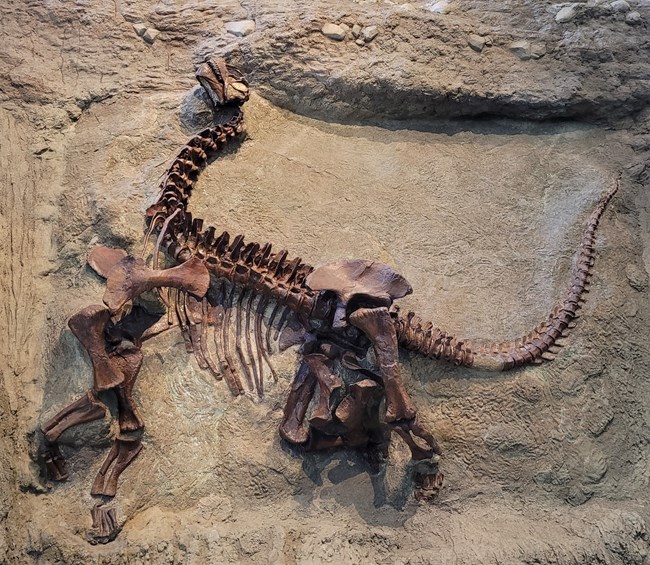
NPS / Bob Walters and Tess Kissinger Camarasaurus lentus was a species of sauropod (long-necked) dinosaur that lived in northeastern Utah during the Late Jurassic Period, about 150 million years ago. Today, its remains are often preserved in the Morrison Rock Formation. Camarasaurus lentus was a plant-eating dinosaur that had robust, spoon-shaped teeth for crushing tougher plants. Its name means "chamber lizard," which referred to the chambered appearance of its vertebrae (backbones). It could grow up to 50 feet (15 meters) in length. While it was shorter in length than some of its sauropod contemporaries, like Apatosaurus, Diplodocus, and Barosaurus, Camarasaurus stood taller. While it sounds huge, Camarasaurus was only a mid-sized sauropod for its time. Amazing SpecimensOn December 17, 1919, Earl Douglass, the paleontologist responsible for overseeing excavations at the Carnegie Quarry, recorded that his team had found an exceptional skull..."Found a skull which belongs with the new skeleton No. 333, skull and lower jaw apparently articulated and perhaps articulated with neck." — Earl Douglass
Douglass's son, Gawin, who preserved his father's diaries in the book, Speak to the Earth and it Will Teach You, attributes this diary entry to a finding of a juvenile Camarasaurus lentus. That specimen (CM 11338) was one of the most complete skeletons of a sauropod ever found. When paleontologists refer to a skeleton or set of bones as being "articulated," it means that the bones are still connected together in the right order as they would have been when the animal was alive. The vertebral (spinal) column is 17 feet (5.2 meters) long, and almost all of it is there, except for a few missing tail bones. The head, neck, legs, and ribs were all correctly articulated with the rest of the body. The fossil even included tiny bones that are usually missing in specimens this old — the bones of the inner ear and the hyoid, a fragile bone in the throat that helps support the tongue and hold it in place, were still present! Paleontologists have guessed that this particular Camarasaurus may have drowned, or perhaps it was mummified on the shore during one of the severe droughts that impacted Late Jurassic Utah. (You can read more about what happened to the quarry dinosaurs on the Morrison Formation webpage). Either way, the skeleton being preserved in a lifelike position suggests that the dinosaur was buried with its connective tissues still intact before decay or scavengers could weaken those connections. In addition to the CM11338 juvenile Camarasaurus skeleton, excavators also found a larger specimen of the same kind of dinosaur in the Carnegie Quarry. The bigger specimen included bones from all four legs, most of the backbone and tail, but also a skull! Finding intact dinosaur skulls is very rare because the bones are so thin. Skulls are also hollow and have many holes in them for soft tissues, like the brain, eyes, and respiratory structures. All of this makes it extremely difficult for skulls to survive the fossilization process without getting crushed. Although bones of Camarasaurus are fairly common in the Morrison Formation, finding a skull is still a treat for paleontologists. The bigger specimen of Camarasaurus was removed from the rock and and prepared as an exhibit in the 1933 World's Fair. Today, it's on display at the Smithsonian National Museum of Natural History in Washington D.C. Answering an Age Old Question: How Did Dinosaurs Stand?At the time of its discovery, the question of how sauropod (long-necked long-tailed) dinosaurs carried themselves was still a source of debate. Some thought that the bone structure of sauropods seemed to indicate that the dinosaurs walked upright, with their legs carried directly beneath the body. Others thought that since most modern reptiles walk with their legs splayed out to the sides, like crocodiles, dinosaurs likely did the same. The CM11338 skeleton of Camarasaurus showed the articulated front legs of the animal in a position carried directly beneath the body. This proved that sauropod dinosaurs walked upright rather than with a splayed stance, forever changing how we view these fascinating animals.
NPS / Nick Guarino, photographed at the Carnegie Museum Preparing the Juvenile Skeleton for DisplayThe specimen of juvenile Camarasaurus that Douglass's team uncovered during the final years of excavation at the Carnegie Quarry was one of the best sauropod skeletons ever found. Because it was so nicely preserved, it has never been completely removed from the sandstone block it was found in. Instead, fossil preparators chose to remove just enough rock to reveal the left side of the dinosaur. However, they did change a few small details. When it was discovered, the dinosaur's back legs were bunched up beneath the body. The tail curved over the animal's back, and the corocoid (a bone that normally sits in the chest) had moved out of its correct position and was sitting by the tail. In order to more accurately depict how the dinosaur would've been structured in life, fossil preparators chose to correct these details. The tail and back legs were straightened, and the corocoid was moved back to its correct position in the chest. Fortunately, both the original and corrected positions were carefully documented by Arthur Sterry Coggeshall in Volume 10 of Memoirs of the Carnegie Museum. Use the photo slider to compare the before and after plates. Today, the real CM11338 juvenile Camarasaurus skeleton can be still be seen at the Carnegie Museum in Pittsburgh Pennsylvania. A cast of CM11338 is on display at Dinosaur National Monument in the Quarry Exhibit Hall.CM11338 Juvenile Camarasaurus: Before and After Repositioning 
Left image
Right image
|
Last updated: March 25, 2025
